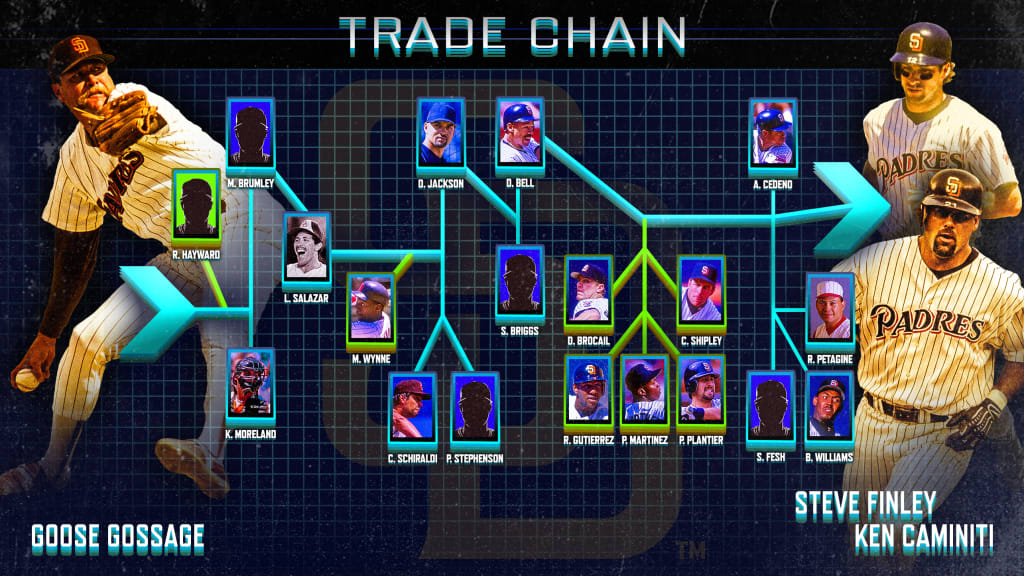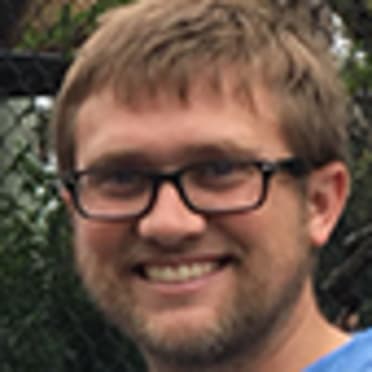
SAN DIEGO -- Goose Gossage is widely regarded as the final piece to the 1984 Padres puzzle. The veteran right-hander signed in January, then played a huge part in the franchise's first National League pennant.
Upon further review, that Gossage signing also indirectly served as one of the first pieces to the 1998 Padres puzzle. An intricate series of trades would follow, leading to the acquisition of Ken Caminiti and Steve Finley a decade later. Eventually, that duo would help spark the Padres’ second NL title.
Here's the full sequence of events -- beginning with Gossage’s signing -- that brought Caminiti and Finley to San Diego:
Jan. 6, 1984: Padres sign Goose Gossage as a free agent
Gossage is arguably the most impactful free-agent signing in franchise history, though Manny Machado might take that crown one day. But for now, the payoff from Gossage's arrival is impossible to ignore.
In 1984, the Padres were a young team brimming with talent but lacking experience. General manager Jack McKeon sensed that his team was nearing contention, so he signed one of the sport's most dominant closers.
“That was a big piece McKeon thought could get the team over the hump,” said former GM Randy Smith, whose first of 24 years with the organization came in 1984. “Here was a guy who had experience winning and knew how to win. He brought a lot to the team. He brought an attitude, along with his ability.”
Gossage would post a 2.90 ERA over 102 1/3 innings, finishing fifth in the NL Cy Young Award voting. The Padres captured the NL crown with Gossage on the mound, as he pitched two scoreless frames to close out a winner-take-all NLCS Game 5.
Feb. 12, 1988: Padres trade Goose Gossage and Ray Hayward to the Cubs for Keith Moreland and Mike Brumley
Four years later, the Padres' window for contention in the NL West had closed. They remained competitive in 1985, and Gossage authored one of the best seasons of his career. But he slumped in '86 and '87 and so did the Padres. Gossage, who had spent most of his career in playoff contention, voiced his displeasure.
McKeon realized a disgruntled 36-year-old closer probably wasn't good value for the rebuilding Padres. So he struck up trade talks with the Cubs, who had dealt Lee Smith to Boston.
Multiple times, McKeon asked the Cubs for Jamie Moyer. They declined. So the Padres settled for third baseman Keith Moreland. To balance the deal, the Cubs added rookie middle infielder Mike Brumley.
March 23, 1989: Padres trade Mike Brumley to the Tigers for Luis Salazar
Brumley spent one season in the Padres' organization. But with Roberto Alomar and Garry Templeton blocking his path, he never cracked the big league club. Still, he put forth an excellent year at Triple-A Las Vegas, slashing .315/.393/.407 over 113 games.
The following spring, Brumley set out to compete for a backup infield job. He would win one -- only not in San Diego. A week before the season, the Tigers took a risk, dealing an established veteran infielder in Salazar for the unproven Brumley. That deal would swing strongly in the Padres' favor as Brumley posted a .534 OPS across parts of eight seasons -- just one with Detroit -- never playing more than 92 games.
“Brumley never hit much, and Salazar was always a McKeon favorite,” Smith recalled. “Jack loved his versatility, the way he played.”
Salazar had begun his career with five strong seasons in San Diego. He would return in his age-33 season as a useful utility piece who started regularly at third base for a few months.
Aug. 30, 1989: Padres trade Luis Salazar and Marvell Wynne to the Chicago Cubs for Darrin Jackson, Calvin Schiraldi and a player to be named later (would become Phil Stephenson)
Salazar batted .268 with a .713 OPS across 95 games for the 1989 Padres. Wynne, meanwhile, slashed .252/.282/.357 while playing solid center field.
But -- on the fringes of the 1989 NL West race -- the Padres looked for an upgrade in their rotation. The first-place Cubs, meanwhile, needed help at third base and in the outfield.
So the two clubs swung a deal in which Wynne and Salazar went to Chicago, and Schiraldi would join the Padres' rotation. Jackson, meanwhile, was tabbed to take over for Wynne in center field.
March 30, 1993: Padres trade Darrin Jackson to the Blue Jays for Derek Bell and Stoney Briggs
Though he wasn't a central figure in the ’89 trade, it’s Jackson who tips the scales in the Padres' favor in any historical assessment of that deal. After sparse playing time in ‘90, Jackson put forth one of the best two-year runs for a center fielder in Padres history.
Jackson was worth 4.4 WAR in consecutive seasons on the 1991 and '92 Padres. But team ownership was authoring a sell-off known as "the fire sale" at the time. When Jackson won his arbitration hearing ahead of the '93 season, he instantly became trade bait.
The defending champion Blue Jays came calling. They had a younger and cheaper outfielder to trade. Bell would spend the next two seasons in San Diego, manning center field next to Tony Gwynn while slashing .284/.325/.433.
Dec. 28, 1994: Padres trade Derek Bell, Doug Brocail, Ricky Gutierrez, Pedro Martinez (not that Pedro Martinez), Phil Plantier and Craig Shipley to the Astros for Ken Caminiti, Steve Finley, Andujar Cedeno, Roberto Petagine, Brian Williams and a player to be named later (would become Sean Fesh)
The deal that sent Caminiti and Finley to San Diego was a certifiable blockbuster. The 12 (twelve!) players involved combined to accumulate more than 100 WAR during the course of their careers.
“We wanted Finley and Caminiti, and Houston was looking to move some salary but still stay competitive, and we matched up,” said Smith, then the Padres' GM. “The deal just kept growing. … They needed this. Well, if you’re going to need that, then we need this piece.”
The specifics of the trade were finalized before Thanksgiving, but with the Padres in the midst of an ownership change, it was put on hold for more than a month before Smith got final approval. In no uncertain terms, the trade would change the trajectory of the franchise.
“We really needed an attitude pick-me-up,” said Hall of Fame closer Trevor Hoffman, who arrived via trade the previous season. “Those two guys in particular brought that confidence to the team. Obviously, we were still transitioning from fire-sale trades to an organization looking for its identity.”
By 1996, Caminiti and Finley had helped the Padres find that identity. Caminiti won the NL MVP Award with arguably the best non-Gwynn season in franchise history. Finley, meanwhile, put forth the best season ever for a Padres center fielder. San Diego won its first NL West crown since '84.
Two years later, the Padres won the pennant, with Caminiti and Finley playing important roles. Both would depart via free agency that offseason, effectively ending the trade tree that began with Gossage. But clearly the Padres extracted plenty of value from those branches.
“It’s funny,” says Smith. “You remember all those deals, but you never piece it together that way. Goose got us there in ’84. Then, if you follow the link, it played a major role in ’98.”


